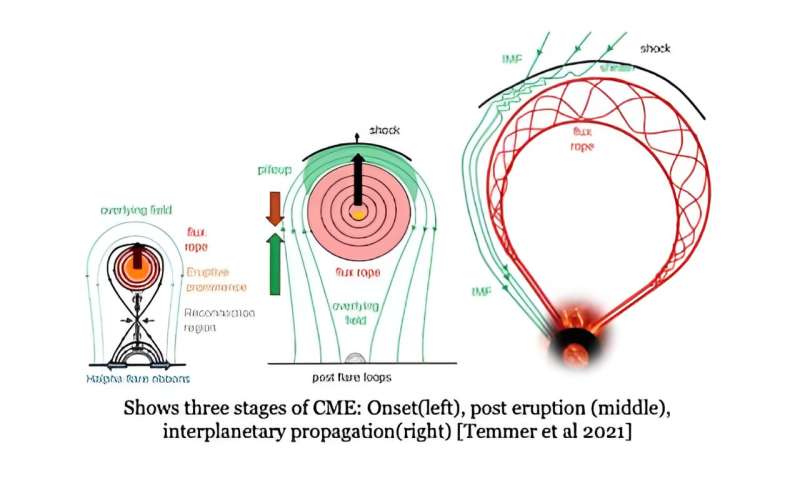
When giant solar storms hit Earth, they trigger beautiful auroral displays high in Earth’s atmosphere. There’s a dark side to this solar activity, though. The “space weather” it sets off also threatens our technology. The potential for damage is why we need highly accurate predictions of just when these storms will impact our planet’s magnetosphere.
To figure that out, scientists in England went to the source: specific places on the sun where these storms erupt. Those outbursts are called coronal mass ejections (CMEs). They’re huge explosions of magnetically charged particles and gases from the sun. They travel through space and hit whatever is in their way, including planets.
When that cloud of charged particles hits our magnetic field, it sets off a chain reaction of events. Of course, it creates beautiful auroral displays—northern and southern lights that dance in the skies. But, they also slam into and can damage orbiting satellites, including all our telecommunications and navigation systems for planes, boats, and trains.
The danger is even greater for astronauts aboard orbiting space stations. That’s because radiation is a constant threat to human life. On Earth, those storms can cause huge circulating electrical currents that can damage electric power grids. The damage to technology just ripples across the planet.
This is why satellite operators and others want more accurate predictions of just when a space weather event triggered by a CME will hit us. To figure that out, solar physicists have to look back at the sun and the sequence of events that cause CMEs.
Studying the solar active regions
CMEs emanate from active regions on the sun. These are places with very strong magnetic fields. The magnetic field lines form loops that get twisted and eventually, they break. When that happens, there’s a huge outburst of material—the CME. Typically, they travel out from the sun at anywhere from 100 km/sec to 3,000 km/sec. That large uncertainty makes it tough to predict when the solar cloud will hit Earth.
Science teams led by Aberystwyth University solar physicist Harshita Ghandhi, focused on the height above the sun where the magnetic field becomes unstable. They call it the “critical height” and it can help scientists predict the speed and arrival time of a coronal mass ejection.
“By measuring how the strength of the magnetic field decreases with height, we can determine this critical height,” said Gandhi. “This data can then be used along with a geometric model which is used to track the true speed of CMEs in three dimensions, rather than just two, which is essential for precise predictions.”
The team found a very strong relationship between the critical height of the CME as it gets started and its true speed as it moves out. “This insight allows us to predict the CME’s speed and, consequently, its arrival time on Earth, even before the CME has fully erupted,” Ghandhi said.
Knowing the actual speed of the CME to a higher degree of accuracy will let solar physicists predict when it will hit Earth. That, in turn, will allow satellite operators, grid owners, space agencies, and others to prepare for the action and protect their assets.
“Understanding and using the critical height in our forecasts improves our ability to warn about incoming CMEs, helping to protect the technology that our modern lives depend on,” Gandhi pointed out.
Solar storms and the damage they cause
Our sun goes through periods where it is more “outbursty” than others. Some of the strongest solar storms occur during the solar maximum part of the sun’s 11-year sunspot cycle. That’s not to say they don’t occur at other times.
Whenever they happen, however, they can cause a lot of damage.
One famous storm occurred on March 13, 1989. It was a combo of two CMEs that lifted off the sun on March 10th and March 12th. They stirred up currents low in Earth’s atmosphere at the same time they triggered auroral displays.
At the time, power grids were not necessarily “hardened” against such events. As a result, the Hydro-Quebec power grid shut down and suffered tremendous damage. The power was out for days across eastern Canada and parts of the United States.
Another huge storm hit around Halloween in 2003. It affected satellite systems, cut off communications, some power systems shut down, and people around the world saw a dazzling display of aurorae. In space, the SOHO solar satellite shut down briefly. Astronauts onboard the ISS had to take shelter in a safe place aboard the station.
Today, we’re in another cycle of heightened solar activity. We’ve already seen strong storms in May of 2024, and more will surely occur. So far, they haven’t caused much damage, and they’ve given us some lovely auroral displays. Luckily, advanced research on these solar storms has helped technology operators and space agencies “harden” their systems.
However, there’s only so much they can do to protect their assets. Having highly accurate advanced predictions of just when a CME will impact our planet is a big step forward. At the very least, these operators will be able to reposition satellites, strengthen their power grids and other communications technology, and give astronauts in space advance warning.
In future years, when we have people on the moon or on their way to Mars, such predictions will help keep them safe, too.
More information:
D. H. Boteler, A 21st Century View of the March 1989 Magnetic Storm, Space Weather (2019). DOI: 10.1029/2019SW002278
Journal information:
Space Weather
Provided by
Universe Today
Predicting solar storms before they leave the sun (2024, August 1)
retrieved 1 August 2024
from https://phys.org/news/2024-08-solar-storms-sun.html
part may be reproduced without the written permission. The content is provided for information purposes only.